How the Florida greyhound ban can be bad | Dr. Justine Lee, DACVECC, DABT
Just this week, Florida voters decided to ban greyhound racing over the next few years in their vote of 69 to 31%. Amendment 13 bans greyhound racing effective January 1, 2021 and will slowly phase it out over the next few years. What’s the problem with this? The dogs. What happens to the these incredible dogs?
First, let me state that I know greyhounds really well. As the former Director of the Blood Donor program when I was on faculty at University of Minnesota, I had several foster greyhounds that I took care of (they also helped save lives by donating blood a few times a year)… and hence why I love this breed.
So, before adopting a rescue greyhound, here’s a few things you need to know about greyhounds:
- Greyhounds are sweet, gentle creatures. In my 20 years of being a veterinarian, I have never met a mean one. Shy ones? Yes. But never a mean one.
- Most people assume greyhounds need lots of exercise. Let me fill you in on a little secret. Greyhounds are very lazy (I like to say “energy conserving”) dogs and don’t like to run more than a short sprint. Don’t adopt them expecting them to jog with you – they prefer a short walk, rather than miles at a time. I joke that greyhounds are the perfect dog for older people. Seriously.
- You should never take greyhounds off leash. Unfortunately, greyhounds often will take off and never come back. So, please leave them leashed only.
- Remember, greyhounds were bred to chase that fake furry bunny on the racetrack. Hence, this breed often isn’t good with other small pets (e.g., cats, ferrets, etc.). I prefer for them to be lone pets (or live with other greyhounds). Don’t get me wrong – some rare ones can live with cats, but I am very careful about this.
- They need unique Martingale dog collar
like this one so their skinny neck doesn’t slip out of a traditional dog collar.
- They are predisposed to really bad dental disease, and need you to commit to brushing their teeth often or scheduling at least a every-other-year veterinary dental cleaning (under anesthesia).
- They have very thin skin; as a result, they often can get scraps and tears in their skin more readily than other breeds.
- Greyhounds don’t “sit.” Before you think about doing obedience with this breed, just be aware they are so muscular, they don’t “sit” like normal dogs.
- Greyhounds often have old orthopedic injuries from the track and may have arthritis when they are older.
- Greyhounds don’t handle stress well – in other words, this breeds seem to be more at risk for separation anxiety and stress colitis (e.g., diarrhea) in my veterinary experience.
- They make amazing blood donors! Here’s my radio show on ER VET (Pet Life Radio) on why you might want to consider having your dog be a blood donor (it helps save another life!).
There are also a few things you need to know that your veterinarian knows about this breed too!
- One never uses an Elizabethan collar on a greyhound; first, they hate it and second, it slips off their skinny little neck. If needed, a temporary occasional neck collar or even plastic muzzle
is needed instead.
- Greyhounds normally have an elevated creatinine (1.4-1.8 mg/dL) due to their muscling.
- Greyhounds often have low platelets on routine blood work (140,000-150,000).
- Greyhounds typically have a higher red blood cell count (RBC) or packed cell volume (PCV) compared to other dogs due to their athleticism.
- Rarely, greyhounds can have clotting abnormalities (estimated to be 10-15%) of the time.
- Greyhounds often have a soft heart murmur (1/6, with 6 being the worst); this is typically due to having a “canine athletic” heart.
- We veterinarians have rarely seen a Greyhound puppy – because they’ve always been raised on tracks!
If you’ve read through that and you’re prepared to help out, here’s what you can specifically do:
- Find a local greyhound rescue organization in your area and help out by volunteering (see more below) or fostering.
- Help volunteer at local events (often to help adopt them out or find homes for them at local fairs, adoption days, etc.)
Regardless of what your stance is on the greyhound racing industry, these dogs need our help getting adopted. Because if they don’t find a home, I’m worried they’ll be euthanized. Please help out today. #ad
Here, some resources to check out – please note, I have never directly worked with most of these, so please do your due diligence and research these rescues first:
- http://www.adopt-a-greyhound.org/
- Northern Lights Greyhound Rescue
- https://www.secondchancegreyhounds.org/
- Greyhound Pet Rescue
Any greyhound owners out there? Weigh in with your thoughts!




You described our 2 greyhounds to a T…except they are actually afraid of our indoor cats! We hope to adopt another greyhound next year.
They are the best, sweetest, dogs ever, aren’t they! 🙂 Thank you for adopting another soon!
Justine,
As a greyhound owner, and one of your co- workers, I’d have to say you’ pretty much covered it here.
My hound is a blood donor, and she’s pretty chill the majority of the time.. but she can ( and does) sit! Just has to be on carpet!
Also, thyroid levels on routine screening can read low.. but a TSH test should rule out a real issue..
Thanks for being such a great advocate for an amazing breed… and know that eventually you’re going to meet C.C.’s “ sibling”…. we plan on adopting another within a few months
The breed in the picture you used is NOT a greyhound!! It is a Magyar Agar, they are not the same as greyhounds. Agars are an entirely different breed of dog. Please get a picture of a real racing greyhound for your article.